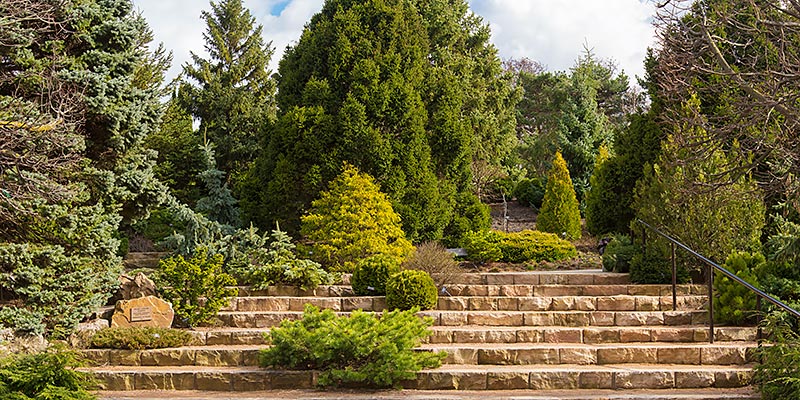

Plant Profiles
Dwarf Conifers
Conifers are trees or shrubs that bear cones.
With a variety of colors, shapes, and sizes, they add color and textural contrast to landscapes year-round.

What exactly are dwarf conifers?
Simply stated, they are conifers that do not reach the normal height for their species. True dwarf conifers average about one-twentieth the typical size, with most species growing from 1 to 6 inches annually and reaching less than 6 feet after ten years. An intermediate dwarf conifer will grow 6 to 15 feet tall over the same decade.
With their small stature, dwarf conifers can be perfect for a small yard or urban plot. Many types maintain their evergreen beauty during winter, providing a welcome focal point in any yard during this bleak time. Their year-round consistency also provides habitat and protection for birds and small animals.
Considering dwarf conifers for your landscape? Be sure to learn the exact characteristics of each, keeping in mind their different foliage and colors, which may differ from the parent or normal species. And don't forget their small size is relative: discover the mature size of each dwarf conifer selection you find interesting, lest you choose one that unhappily exceeds your expectations.
What Causes a Dwarf Conifer?
Several conditions and factors can cause a conifer species to grow naturally as a dwarf — including, sometimes, a harsh climate or poor soil condition. Seedling mutations also create dwarf conifers. Bud mutations (or, as they are sometimes called, “sports”) can also introduce changes in a particular bud from the normal growing parent to a dwarfed habit. Finally, tangled, dense clumps of branchlets sometimes grow on full-sized conifers. Called witches' brooms, they can result from disease or genetic mutation. All of these types of changes can then be propagated.
A deliberate method of cultivating dwarf conifers is through grafting. Cultivators graft a normal growing species onto a dwarf rootstock, which actually slows down the growth of the conifer, in turn creating a new dwarf cultivar. Dwarf varieties also can be created through the process of growing standards, or a plant that has a long single stem. In this case a rootstock is trained to create vertical growth, and the dwarf conifer is grafted above on a long stem. The development and training of new cultivars through plant breeding also creates dwarf varieties.
A Look at Conifer Seeds
Cones are ancient structures that protect the tree's seeds, which shelter beneath each of the cone's woody scales. Young green cones are sealed tight by resin. Once the seeds inside mature (after several months to several years), the cone turns brown and its scales open. The seeds are dispersed by wind or by animals, and the empty cone falls to the ground. Some dwarf conifers don't produce cones at all (they have a long juvenile phase), some bear small ones, and others bear full-sized cones despite the tree's small stature.
Caring for Your Dwarf Conifers
Different species of dwarf conifers require different growing conditions — though there are some general guidelines. Most require full sun to light shade and well-drained soil (some require slightly acidic soil conditions). When you first plant a dwarf conifer, be sure that it receives 1 inch of water per week (supplement if there isn't enough rainfall). Mulch around your dwarf conifer — but not directly around its trunk — to improve moisture retention and increase soil nutrients. Watch for branches that look like they could revert back to faster growth; prune them out immediately. Dwarf conifers typically do not need fertilization. Above all, don't forget to learn about the specific needs of your type of dwarf conifer.
Dwarf forms can be used in innovative ways. You may plant dwarf conifers around garden pools and in rock gardens, and miniature dwarf conifers (remaining under a foot in height) are ideal in containers. When planted near ornamental grasses, dwarf conifers maximize the contrast between airy/dense textures and light/dark colors. Prostrate (horizontal) or matted forms make attractive groundcovers. When dwarf conifers are planted as a group, choose an odd number (3, 5, 7) of different shapes. This is especially effective where winter interest is needed.
Dwarf Conifers for the Chicago Region
Dwarf conifers for the Chicago region are available in a great variety of sizes, shapes, and textures — as well as a four-season palette including every shade of green, unexpected blues, and silvers, complemented by spring growth in yellow and white, and winter foliage in red, copper, or bronze. Below are some dwarf conifer cultivars with interesting characteristics that are hardy for this area:
- Abies concolor 'Compacta' (Compact White Fir) has bluish-gray foliage in an upright habit.
- Chamaecyparis pisifera 'Gold Spangled' (Sawara Falsecypress) has yellow, feathery foliage throughout the year.
- Chamaecyparis pisifera 'Plumosa juniperoides' (Juniper-Plume Dwarf Sawara Falsecypress) has pale yellow new growth in the spring, contrasting with the darker inner foliage, turning golden in the summer.
- Larix decidua 'Whorled Peace' (European Larch) is a deciduous conifer featuring branches with a curving form that collectively look like spiraling water.
- Picea abies 'Repens Gold' (Dwarf Norway Spruce) has golden-green, feathery foliage.
- Picea abies 'Elegens' (Dwarf Norway Spruce) is a low-growing, green, spreading conifer.
- Picea pungens 'Sunshine' (Colorado Blue Spruce) has a slight golden look to its foliage, as its new growth is light yellow and older growth turns silver-green as it matures, growing pyramidal in shape.
- Picea pungens 'Glauca Pendula' (Weeping Colorado Blue Spruce) has the blue foliage of the Colorado Spruce in a weeping, dwarf form.
Be sure to visit the Dwarf Conifer Garden at the Chicago Botanic Garden to view these and many more dwarf conifers.

